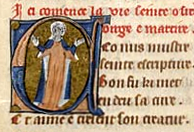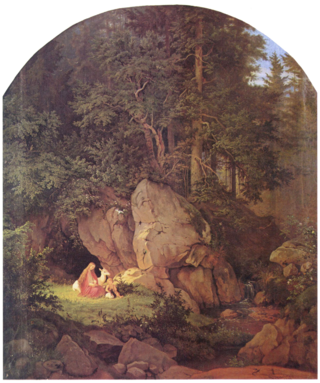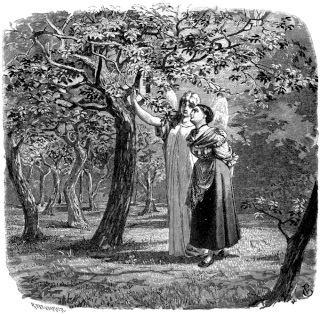
Offa is a semi-legendary king of the Angles in the genealogy of the kings of Mercia presented in the Anglo-Saxon Chronicle. He is the son of Wermund and the father of Angeltheow. His name is also mentioned in the Old English poem Widsith. He has been identified with Uffo, a legendary Danish king in the Gesta Danorum by Saxo Grammaticus.

Matthew Paris, also known as Matthew of Paris, was an English Benedictine monk, chronicler, artist in illuminated manuscripts, and cartographer who was based at St Albans Abbey in Hertfordshire. He authored a number of historical works, many of which he scribed and illuminated himself, typically in drawings partly coloured with watercolour washes, sometimes called "tinted drawings". Some were written in Latin, others in Anglo-Norman or French verse. He is sometimes confused with the nonexistent Matthew of Westminster.

The Flores Historiarum is the name of two different Latin chronicles by medieval English historians that were created in the 13th century, associated originally with the Abbey of St Albans.

Osgyth was a Mercian noblewoman and prioress, venerated as an English saint since the 8th century, from soon after her death. She is primarily commemorated in the village of St Osyth, in Essex, near Colchester. Alternative spellings of her name include Sythe, Othith and Ositha. Born of a noble family, she became a nun and founded a priory near Chich which was later named after her.

"The Man of Law's Tale" is the fifth of the Canterbury Tales by Geoffrey Chaucer, written around 1387. John Gower's "Tale of Constance" in Confessio Amantis tells the same story and may have been a source for Chaucer. Nicholas Trivet's Les chronicles was a source for both authors.
Gesta Romanorum, meaning Deeds of the Romans, is a Latin collection of anecdotes and tales that was probably compiled about the end of the 13th century or the beginning of the 14th. It still possesses a two-fold literary interest, first as one of the most popular books of the time, and secondly as the source, directly or indirectly, of later literature, in Geoffrey Chaucer, John Gower, Giovanni Boccaccio, Thomas Hoccleve, William Shakespeare, and others.

Genevieveof Brabant is a heroine of medieval legend. The story is told in the "Golden Legend" and concerns a virtuous wife falsely accused of infidelity.

The Angles were a dominant Germanic tribe in the Anglo-Saxon settlement of Britain, and gave their name to the English, England and to the region of East Anglia. Originally from Angeln, present-day Schleswig-Holstein, a legendary list of their kings has been preserved in the heroic poems Widsith and Beowulf, and the Anglo-Saxon Chronicle.

Æthelberht, also called Saint Ethelbert the King, was an eighth-century saint and a king of East Anglia, the Anglo-Saxon kingdom which today includes the English counties of Norfolk and Suffolk. Little is known of his reign, which may have begun in 779, according to later sources, and very few of the coins he issued have been discovered. It is known from the Anglo-Saxon Chronicle that he was killed on the orders of Offa of Mercia in 794.

Modthryth, Thryth, and Fremu are reconstructed names for a character who figures as the queen of King Offa in Beowulf.

"Allerleirauh" is a fairy tale recorded by the Brothers Grimm. Since the second edition published in 1819, it has been recorded as Tale no. 65. Andrew Lang included it in The Green Fairy Book.

"The Girl Without Hands" or "The helpless Maiden" or "The Armless Maiden" is a German fairy tale collected by the Brothers Grimm. It is tale number 31 and was first published in the 1812 edition of Children's and Household Tales. The story was revised by the Grimm brothers over the years, and the final version was published in the 7th edition of Children's and Household Tales in 1857. It is Aarne-Thompson type 706.

Cynethryth was a Queen of Mercia, wife of King Offa of Mercia and mother of King Ecgfrith of Mercia. Cynethryth is the only Anglo-Saxon queen consort in whose name coinage was definitely issued.

The Chronica Majora is the seminal work of Matthew Paris, a member of the English Benedictine community of St Albans and long-celebrated historian. The work begins with Creation and contains annals down to the year of Paris' death of 1259. The Chronica has long been considered a contemporary attempt to present a universal history of the world.
Emaré is a Middle English Breton lai, a form of mediaeval romance poem, told in 1035 lines. The author of Emaré is unknown and it exists in only one manuscript, Cotton Caligula A. ii, which contains ten metrical narratives. Emaré seems to date from the late fourteenth century, possibly written in the North East Midlands. The iambic pattern is rather rough.
Le Bone Florence of Rome is a medieval English chivalric romance. Featuring the innocent persecuted heroine, it is subcategorized into the Crescentia cycle of romances because of two common traits: the heroine is accused by her brother-in-law after an attempted seduction, and the story ends with her fame as a healer bringing all her persecutors to her.
The Erl of Toulouse is a Middle English chivalric romance centered on an innocent persecuted wife. It claims to be a translation of a French lai, but the original lai is lost. It is thought to date from the late 14th century, and survives in four manuscripts of the 15th and 16th centuries. The Erl of Toulouse is written in a north-east Midlands dialect of Middle English.

Michael James Swanton is a British historian, linguist, archaeologist and literary critic, specialising in the Anglo-Saxon period and its Old English literature.
Crescentia is an Early Middle High German language chivalric romance, included in the Kaiserchronik about 1150. Other versions appeared in the thirteenth and fourteenth centuries, in prose and verse.
Margaret Schlauch was a scholar of medieval studies at New York University and later, after she left the United States for political reasons in 1951, at the University of Warsaw, where she headed the departments of English and General Linguistics. Her work covered many topics but included focuses on Chaucer, Anglo-Saxon, and Old Norse literature.















